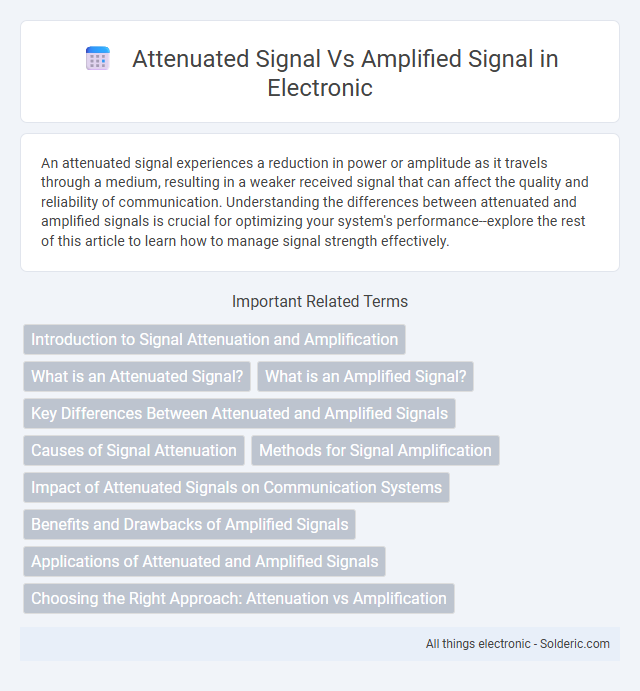An attenuated signal experiences a reduction in power or amplitude as it travels through a medium, resulting in a weaker received signal that can affect the quality and reliability of communication. Understanding the differences between attenuated and amplified signals is crucial for optimizing your system's performance--explore the rest of this article to learn how to manage signal strength effectively.
Comparison Table
| Feature | Attenuated Signal | Amplified Signal |
|---|---|---|
| Definition | Signal with reduced power or strength | Signal with increased power or strength |
| Purpose | Lower signal level to prevent distortion or match system requirements | Boost signal to improve transmission distance or clarity |
| Effect on Amplitude | Decreases amplitude | Increases amplitude |
| Effect on Noise | May reduce noise level by lowering signal power | May amplify noise along with the signal |
| Common Usage | Signal conditioning, impedance matching | Signal boosting in transmitters and receivers |
| Example Components | Attenuators, resistors | Amplifiers, operational amplifiers |
Introduction to Signal Attenuation and Amplification
Signal attenuation refers to the reduction in signal strength as it travels through a medium, causing potential loss of data quality and clarity. Amplification involves boosting the signal power to restore or enhance its strength, ensuring effective transmission over longer distances. Understanding the balance between attenuated signal and amplified signal is crucial for maintaining optimal performance in communication systems.
What is an Attenuated Signal?
An attenuated signal is a weakened electrical or electromagnetic signal that experiences a reduction in power or amplitude as it travels through a medium or network. Signal attenuation occurs due to factors like distance, resistance, interference, or physical obstructions, resulting in loss of signal strength. Attenuated signals often require amplification or regeneration to restore quality for effective communication or data transmission.
What is an Amplified Signal?
An amplified signal is an electrical signal whose amplitude has been increased using an electronic amplifier to enhance its strength without altering the original information content. Amplifiers boost weak signals from sources like microphones or antennas to levels suitable for processing, transmission, or driving output devices such as speakers. This amplification ensures clearer communication, improved signal-to-noise ratio, and greater transmission distances in audio, radio, and telecommunications systems.
Key Differences Between Attenuated and Amplified Signals
Attenuated signals experience a reduction in strength as they travel through a medium, leading to lower amplitude and potential loss of data quality, whereas amplified signals are boosted in amplitude to counteract signal loss and maintain clear transmission. Key differences include the purpose--attenuation diminishes signal power often due to distance or obstacles, while amplification increases signal power to restore intensity. Understanding these distinctions helps you optimize communication systems for reliable and efficient signal processing.
Causes of Signal Attenuation
Signal attenuation occurs due to factors such as distance, where the signal loses strength as it travels through a medium, and physical obstructions like walls and buildings that absorb or reflect the signal. Interference from other electronic devices and poor quality cables also contribute to signal degradation. Understanding these causes helps you optimize network performance by minimizing signal loss and maintaining stronger, amplified signals.
Methods for Signal Amplification
Methods for signal amplification primarily include the use of electronic amplifiers such as transistor-based amplifiers, operational amplifiers, and radio frequency (RF) amplifiers, which increase signal strength without significantly degrading the signal-to-noise ratio. Amplifiers utilize active components like bipolar junction transistors (BJTs), field-effect transistors (FETs), and vacuum tubes to boost weak or attenuated signals for clearer transmission and processing. Techniques such as regenerative amplification and low-noise amplification optimize the gain and fidelity of weak signals in communication and audio systems.
Impact of Attenuated Signals on Communication Systems
Attenuated signals in communication systems result in weakened signal strength, leading to increased bit error rates and reduced data transmission quality. Signal attenuation can cause your devices to struggle with maintaining reliable connectivity, especially over long distances or through obstacles. Amplification of signals counteracts attenuation by boosting signal power, but excessive amplification may introduce noise and distortion, affecting overall system performance.
Benefits and Drawbacks of Amplified Signals
Amplified signals increase signal strength to improve transmission range and overcome loss from cables and connectors, enhancing overall communication quality. However, they can introduce noise and distortion, potentially degrading signal integrity if amplification is excessive or poorly designed. Careful amplification is required to balance improved reach with maintaining signal fidelity for optimal system performance.
Applications of Attenuated and Amplified Signals
Attenuated signals are crucial in applications such as signal testing, where reducing signal strength prevents distortion and protects sensitive equipment. Amplified signals are essential in communication systems, enabling long-distance transmission by boosting weak signals to maintain clarity and data integrity. Both processes optimize signal quality for specific functions in telecommunications, audio engineering, and instrumentation.
Choosing the Right Approach: Attenuation vs Amplification
Choosing between attenuation and amplification depends on the signal's strength and the system's requirements. Attenuation reduces signal power to prevent overload and distortion, commonly used in high-frequency communications and sensitive electronic circuits. Amplification increases signal strength to improve transmission distance and clarity, essential in weak signal environments and long-distance communication systems.
attenuated signal vs amplified signal Infographic

 solderic.com
solderic.com